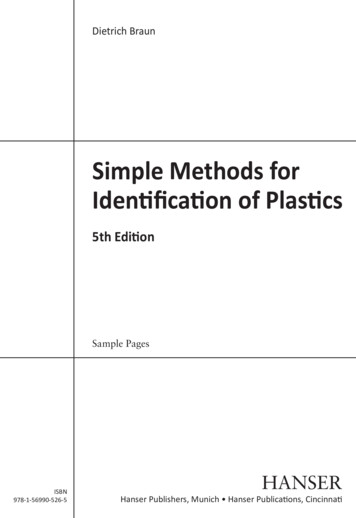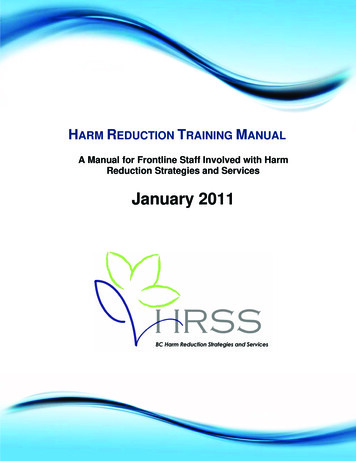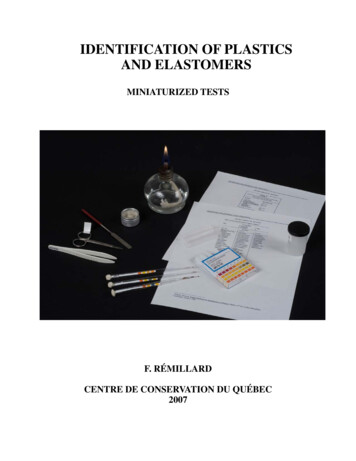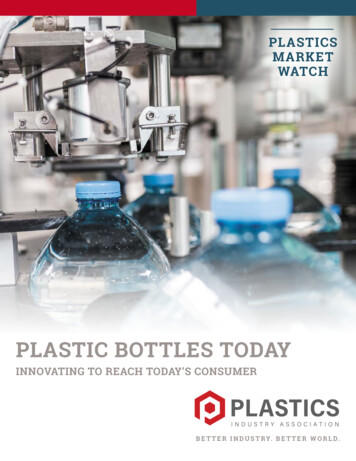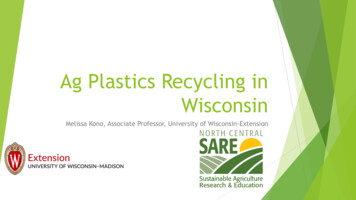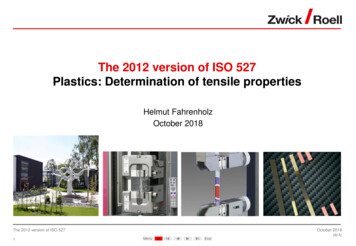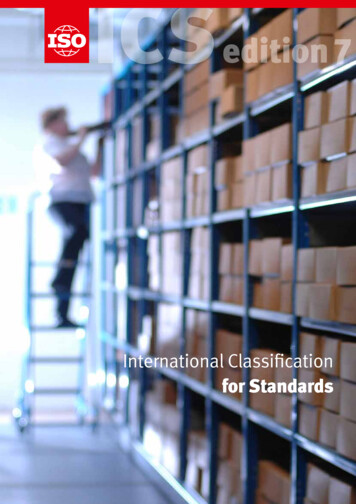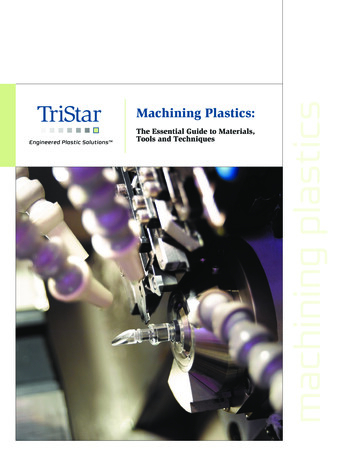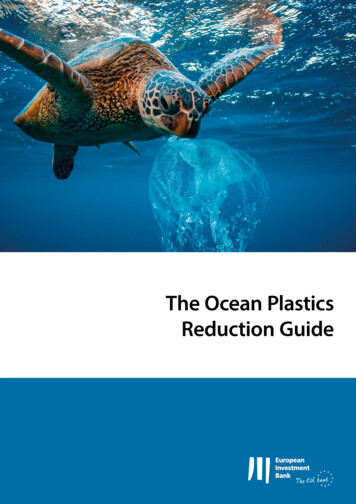
Transcription
The Ocean PlasticsReduction Guide
The Ocean PlasticsReduction Guide
The Ocean Plastics Reduction Guide European Investment Bank, 2021.98 -100, boulevard Konrad Adenauer – L-2950 Luxembourg3 352 4379-1U /europeaninvestmentbankyoutube.com/eibtheeubankAll rights reserved.All questions on rights and licensing should be addressed to publications@eib.orgPhoto credits: EIB, Shutterstock (Gigira, Fotos593, Antonio V. Oquias, Maxim Blinkov, Baloncici).All rights reserved.Authorisation to reproduce or use these photos must be requested directly from the copyrightholder.For further information on the EIB’s activities, please consult our website, www.eib.org.You can also contact info@eib.org. Get our e-newsletter at www.eib.org/sign-upPublished by the European Investment Bank.Printed on FSC Paper.The EIB uses paper certified by the Forest Stewardship Council (FSC). Because it’s made by peoplewho like trees.FSC promotes environmentally sound, socially beneficial, and economically viable management ofthe world’s forests. We all know reading is good for you. It’s good for the planet, too – as long as youread on the right paper.eBook: QH-02-21-658-EN-E ISBN 978-92-861-5028-9 doi:10.2867/506827pdf: QH-02-21-658-EN-N ISBN 978-92-861-5029-6 doi:10.2867/588812
ContentsPreamble51. Introduction61.1.1.2.1.3.The oceansThreats to the oceansThe need for ocean conservation2. Ocean plastic pollution2.1.2.2.2.3.2.4.2.5.Global plastic production and waste handlingSources of plastics discharge into the oceansImpact of ocean plastics on marine ecosystemsImpact of ocean plastics on fisheries and other economic activitiesImpact of ocean plastics on climate3. The challenges of ocean plastics3.1.3.2.3.3.3.4.Technical challengesRegulatory and governance challengesInstitutional challengesFinancing challenges4. Technical solutions to ocean plastic tic reduction and preventionImproved solid waste managementImproved wastewater and stormwater management2325265. Regulatory and institutional solutions to ocean plastic pollution285.1.5.2.Regulatory measuresMarket-based instruments and voluntary agreements6. Clean ocean financing6.1.6.2.6.3.Approaches to financing ocean plastics reductionThe Clean Oceans InitiativeOther sources of clean ocean financing2830313132337. Impact measurement and monitoring36Annex A The ocean regulatory framework38Annex B The Clean Oceans Initiative target sectors39Annex C Clean ocean initiatives40
List of FiguresFigure 1: Plastic waste accumulating in pristine watersFigure 2: Plastics in an open dumpsite in Mukdahan Province, ThailandFigure 3: Plastics washed ashore on a beach next to the Panama CanalFigure 4: Waterway filled with plastics in Manila, the PhilippinesFigure 5: Small crab entangled in a plastic bagFigure 6: Ghost fishing in an abandoned fishing netFigure 7: Plastics accumulating on Kuta Beach, BaliFigure 8: LanternfishFigure 9: Old fishing gearFigure 10: Fresh milk from farm vending machine at farmers market in Ljubljana, SloveniaFigure 12: Mangrove forestFigure 13: Garbage filtering system across a river in Cebu City, the Philippines8911121415161719232727List of TablesTable 1: Top ten global rankings for mismanaged plastic wastes in 2010AbbreviationsADBAfDBASEANCDPCOIEIBUNDPAsian Development BankAfrican Development BankAssociation of Southeast Asian NationsCassa Depositi e PrestitiClean Oceans InitiativeEuropean Investment BankUnited Nations Development Programme10
PreambleThe objective of this guide is to raise awareness about the crucial socioeconomic, environmentaland climate importance of the oceans, and the growing existential threats posed by plasticsdischarged into and accumulating in the oceans.The guide illustrates how the lack of or substandard management systems for solid waste andwastewater in many coastal cities, especially in sub-Saharan Africa and Asia, contribute to theproblem. It then highlights how the problem will increase unless action is taken due to increasingglobal production and use of plastics.After presenting the key regulatory, institutional, technical and financing challenges and barriersto addressing the ocean plastics problem, the guide discusses ways to reduce and prevent plasticdischarge by addressing these challenges and barriers.Given the importance of financing, the guide identifies numerous sources of financing forplastic-reduction projects, including the Clean Oceans Initiative,1 under which the EuropeanInvestment Bank and four other European financing institutions support projects that reduceocean plastics discharge.The guide is intended to inspire policymakers, planners, project promoters and other stakeholdersto engage in addressing the ocean plastics problem and catalyse impactful action and change.While the guide concentrates on oceans, the problems highlighted are equally important andsolutions proposed equally relevant for the seas and for larger lakes and rivers.1See section 6.2.Preamble5
1. Introduction1.1. The oceansOceans and seas cover about 75% of the earth’s surface, contain nearly 200 000 identified species,2and generate more than 50% of the planet’s oxygen.3Oceans are a global public good benefiting most countries and people, including current andfuture generations, by providing essential ecosystem services and natural resources, includingfood and feed; new active ingredients for improved plant, animal and medical products; andrenewable energy. As such, oceans play a vital role in the world economy and will be central tothe post-COVID-19 global economic recovery.According to the United Nations Development Programme (UNDP), more than 3 billion peopledepend on coastal and marine biodiversity for their livelihood, while the global market value ofmarine and coastal resources and industries is approximately 3 trillion per year (5% of globalgross domestic product).4 Ocean-based industries make a significant contribution to employmentgrowth. The sector is projected to provide about 40 million full-time equivalent jobs by 2030.5Strong growth is expected in tourism, aquaculture, fish processing, offshore wind, shipbuildingand repair.The oceans are the world’s largest active carbon reservoir, absorbing about 30% of humanCO2 emissions to the atmosphere.6 Oceans also absorb a large share of the excess heat causedby increasing greenhouse gas emissions into the atmosphere. As such, oceans are essential inregulating the global climate.234566“Goal 14: Life below water,” United Nations Development Programme (UNDP). (link)“How much oxygen comes from the ocean?” National Oceanic and Atmospheric Administration. (link)“Goal 14: Life below water,” UNDP. (link)“The ocean economy in 2030,” Organisation for Economic Co-operation and Development. (link)“Goal 14: Life below water,” UNDP. (link)The Ocean Plastics Reduction Guide
1.2. Threats to the oceansOceans face several threats, with the increasing accumulation of plastics being one of the mostalarming. There are more than 5 trillion pieces of plastic afloat in the oceans.7 About 8 milliontonnes of plastic litter8 and 1.5 million tonnes of microplastics are discharged into the oceansevery year,9 primarily from coastal or riverine cities with limited waste and wastewater collectionand no or substandard systems of waste disposal and wastewater treatment. Rivers collectivelydischarge between 0.47 million and 2.75 million tonnes of plastics into the oceans per year.10Just ten rivers, eight in Asia and two in Africa, carry about 93% of river-transported plastics tothe oceans.11 The Yangtze in China discharges approximately 1.5 million tonnes of plastic wasteinto the Yellow Sea every year,12 while the Indus and the Ganges flowing through India carry thesecond and sixth highest quantities of plastic wastes to the oceans.13 The other rivers on thislist are the Amur, Hai, Pearl, Mekong and Yellow River in Asia, and the Niger and Nile in Africa.Ocean plastics are discharged in different forms, most common of which are single-use items suchas bags, water bottles, straws, food containers and cutlery. These items are used and discardedquickly but can circulate in the oceans for centuries if not properly managed on land. A largeshare of the ocean plastics break down into tiny pieces or microplastics that further endangermarine ecosystems.Oceans also face other threats, such as coastal pollution, for example from nutrients and pollutantsin untreated wastewater or from unsustainable agriculture; oil spill; overfishing; acidification; andglobal warming. Untreated wastewater from industrial plants and factories, and agrochemicalrun-off end up in the oceans, resulting in oxygen depletion that threatens marine plants and fish.In addition, overfishing has been identified as a major challenge in most parts of the world. TheUnited Nations Food and Agriculture Organization estimates that close to 31.4% of fish stocksare either fished to capacity or overfished.14 Consequently, the ocean’s natural assets are underenormous pressure, with the health of many ocean ecosystems already in steep decline.157 “Plastic pollution in the world’s oceans: more than 5 trillion plastic pieces weighing over 250,000 tons afloat at sea,” Eriksen, Marcus, et al. PloS ONE 9, no. 12, 2014.(link)8 “Plastic waste inputs from land into the ocean.” Jambeck, Jenna, et al. Science 347, no. 6223, 2015. (link)9 “Primary microplastics in the oceans: A global evaluation of sources,” Boucher, Julien, and Damien Friot. International Union for Conservation of Nature, Gland,Switzerland, 2017. (link).10 “Stemming the Plastic Tide: 10 Rivers Contribute Most of the Plastic in the Oceans,” Patel, Prachi. Scientific American, 2018. (link)11 Ibid.12 Ibid.13 “Export of plastic debris by rivers into the sea,” Schmidt, Christian, Tobias Krauth, and Stephan Wagner. Environmental Science & Technology 51, no. 21, 2017. (link)14 “The state of world fisheries and aquaculture,” Food and Agriculture Organization, 2016. (link)15 “Global Assessment Report on Biodiversity and Ecosystems Services,” Brondizio, Eduardo., et al . IPBES Secretariat, Bonn, Germany, 2019. (link)Introduction7
1.3. The need for ocean conservationConservation and sustainable use of the world’s oceans are recognised in UN SustainableDevelopment Goal 14 (Life below Water). Moreover, many countries, international organisationsand companies producing or using plastics have announced their priority given to conserving andprotecting the oceans, recognising the significance of the ocean environment for the economyand climate regulation. There is growing realisation that marine litter greatly reduces the totaleconomic value of the marine environment.The European Commission’s Communication on a Sustainable Blue Economy16 aligns the EU’socean and maritime policy with the goals of the European Green Deal. It commits the EU to aclimate-neutral blue economy and to the targets for protecting marine biodiversity and pollutionfree seas and oceans in the Zero pollution action plan for air, water and soil17.The European Commission has identified “healthy oceans, seas, coastal and inland waters” as oneof five major research and innovation missions under the Horizon Europe programme, whichforms part of the 2021–2027 Multiannual Finance Framework.Figure 1: Plastic waste accumulating in pristine waters16 EU Communication on a Sustainable Blue Economy (link)17 EU Zero pollution action plan for air, water and soil. (link)8The Ocean Plastics Reduction Guide
2. Ocean plastic pollution2.1. Global plastic production and waste handlingThe annual production of plastics increased nearly 200-fold from around 1950, when industrialscale production started, to 2015.18 The cumulative global production of plastics during 1950–2015was 8.3 billion tonnes,19 of which an estimated 6.3 billion tonnes became waste. Only around9% of this waste has been recycled, with 12% incinerated and the remaining 79% accumulatingin landfills or the natural environment, including the oceans.20 This shows the great need andpotential to increase the level of plastic recycling, which would also reduce the share reachingthe oceans.Figure 2: Plastics in an open dumpsite in Mukdahan Province, Thailand18 “Plastic pollution,” Ritchie, Hannah, and Max Roser. Our World in Data, September 2018. (link)19 “More than 8.3 billion tons of plastics made: Most has now been discarded,” ScienceDaily. University of Georgia, 19 July 2017. (link)20 “Production, use, and fate of all plastics ever made,” Geyer, Roland, Jenna Jambeck and Kara Lavender Law. Science Advance 3 no. 7, 19 July 2017. (link)Ocean plastic pollution9
Plastics can be very useful materials; their many contributions include reducing food wastageand the weight of vehicles. However, plastic waste that is dumped, rather than collected, ordisposed in dumpsites or substandard landfills can be carried by the wind and stormwaterdrainage systems to rivers and then oceans. It has been estimated that up to 80–90% of plasticwastes generated across some countries in sub-Saharan Africa and South Asia are inadequatelydisposed of and consequently end up in the environment or oceans,21 with devastating impacton flora and fauna.The problem of mismanaged plastic wastes cuts across different geographical regions andcountries, with particular concentration in low- and medium-income countries. Table 1 lists thetop ten ranked countries for amount of mismanaged plastic wastes in 2010.Table 1: Top ten global rankings for mismanaged plastic wastes in 2010RankCountryMismanagedplastic wastes(tonnes)% of global total ofmismanaged plasticwastesPlastic marine 54.Vietnam1.835.80.28–0.735.Sri 50.12–0.31Source: Jambeck et al., 201521 “Plastic pollution,” Ritchie, Hannah, and Max Roser. Our World in Data, September 2018. (link)10The Ocean Plastics Reduction Guide
Approximately 80% of ocean plastics originate from land-based littering and poor disposalpractices. Inadequate disposal of old fishing nets, ropes and lines also contributes a significantshare of ocean plastics. It is important to note that plastic debris floating on the surface accountsfor only about 5% of all plastic litter discharged into the oceans. The remaining 95% is submerged,with a large share accumulating on the sea floor.22The Breaking the Plastic Wave study23 predicts that if we fail to act, by 2040: the volume of plastic on the market will double compared to 2016; the annual volume of plastic entering the ocean will almost triple, from 11 million tonnesin 2016 to 29 million tonnes in 2040;24 ocean plastic stocks will quadruple to over 600 million tonnes compared to 2016.Figure 3: Plastics washed ashore on a beach next to the Panama Canal22 “Marine plastic pollution,” Ocean Unite, 2020. (link)23 “Breaking The Plastic Wave: Top findings for preventing plastic pollution,” Reddy, Simon, and Winnie Lau. The PEW Charitable Trusts, 2020. (link)24 Ibid.Ocean plastic pollution11
2.2. Sources of plastics discharge into the oceansThere are various sources of macro- and microplastics discharged into the oceans, including: land-based plastics discharged in coastal cities and towns; plastics accumulating in rivers, compounding the land-based discharges from upstreamriverine cities and towns; plastics discharged from oceanic activities; microplastics in non-collected or non-treated wastewater or stormwater dischargedinto rivers and oceans.The main reasons for these plastics discharges are presented below.Illegal plastic littering is caused by lack of or poor waste collection services, a problem morepronounced in informal settlements not served by formal waste collection services. The estimatethat about 2 billion people lack access to organised waste collection services25 illustrates theextent of this problem.Figure 4: Waterway filled with plastics in Manila, the Philippines25 “The mounting problem: World’s cities produce up to 10 billion tonnes of waste each year, UN study estimates,” UN Environment Programme, 7 September 2015.(link)12The Ocean Plastics Reduction Guide
Illegal and substandard waste dumping and disposal is caused by a lack of properly sited,designed and operated landfills and dumpsites leading to clandestine waste dumping. Whensuch dumpsites are located next to rivers or the coast, they may discharge waste when full orduring storm or flood events. Some communities without disposal sites even dispose of collectedwaste directly in rivers. An estimated 3 billion people have no access to adequate waste disposalfacilities,26 showing the scale of this issue.Plastics of marine origin emanate from ships of different kinds, discharge or loss of fishing gearat sea, and plastic waste from sea-based aquaculture.27No or insufficient stormwater/wastewater collection and treatment leads to the dischargeof microplastics into water bodies. These microplastics originate, for example, from tyre abrasion,cosmetic microbeads, and fibres released from synthetic clothing during washing.During rainy seasons/days, run-off water transports plastics and other waste from streets andopen spaces to stormwater drains and canals, where their accumulation reduces hydrauliccapacity. Storms and heavy rains may then lead to flooding until the flow is high enough totransport the accumulated plastics and waste to rivers, lakes or oceans.Finally, environmental and natural factors such as wind and ultraviolet radiation result infragmentation and plastic dispersion.2.3. Impact of ocean plastics on marine ecosystemsMarine litter has been found inside birds, turtles, mammals, and fish of different types and sizes.Microplastics have also been detected in some filter-feeding organisms such as mussels. TheUnited Nations estimates that at least 800 species of marine organisms and microorganismsare affected by plastic debris.28 The most visible and disturbing effects of plastics in the oceansare presented below.Ingestion of plastic debris increases susceptibility to blockage of and physical damage to theintestinal tract. Uptake of polychlorinated biphenyl in the marine food chain causes reproductivehealth complications due to ingested plastic weight. Entanglement in ropes, plastic debris andabandoned fishing nets causes lacerations, infections, reduced mobility and internal injuriesfor many marine species. Plastics can also affect turtles’ reproduction rates by changing thetemperature of the sand in which they incubate eggs.26 “The mounting problem: World’s cities produce up to 10 billion tonnes of waste each year, UN study estimates,” UN Environment Programme, 7 September 2015.(link)27 “Sources, transport, and accumulation of different types of plastic litter in aquatic environments: A review study,” Schwarz, Anne, Tom Ligthart, Elise Boukris, andToon van Harmelen. Marine Pollution Bulletin 143, June 2019. (link)28 “Microplastics, microbeads and single-use plastics poisoning sea life and affecting humans,” UN News, 9 November 2019. (link)Ocean plastic pollution13
Plastics kill more than a million seabirds every year and raise other species’ susceptibilityto contamination; for example, dolphins are vulnerable to plastic ingestion through their prey.Microplastics are likely to concentrate persistent organic pollutants in the food chain throughbiomagnification. Floating plastics can also serve as a vector for the spread of species withslow mobility, invasive species and bacteria that are detrimental to the marine ecosystem,particularly its diversity.Figure 5: Small crab entangled in a plastic bag14The Ocean Plastics Reduction Guide
2.4. Impact of ocean plastics on fisheries and othereconomic activitiesPlastic waste clogs waterways and disrupts essential socioeconomic activities such as aquaculture,fisheries, tourism and shipping.In aquaculture, marine debris damages propellers and equipment, resulting in staff downtime.In fisheries, marine litter can negatively affect fishing vessels’ propellers and fishing equipment,thereby reducing efficiency and revenues. Ghost fishing, whereby derelict gear and lost/abandoned nets remain in the marine environment, can trap fish and other marine life for longperiods, entangling and potentially killing marine species.29 This can reduce fish stocks and catchavailable. In a study to investigate the economic impact of marine litter on coastal communitiesin the Northeast Atlantic region, John Mouat et al. (2010) identified that among surveyed Scottishfishing vessels, 86% had experienced a restricted catch due to marine litter, 82% had encountereda contaminated catch, and 95% had snagged their nets on debris on the seabed.30Figure 6: Ghost fishing in an abandoned fishing net29 “Economic Impacts of Marine Litter,” Mouat, John, Rebeca Lopez Lozano, and Hannah Bateson. Kommunernes Internasjonale Miljøorganisasjon, 2010. (link)30 Ibid.Ocean plastic pollution15
Coastal communities and tourism incur extra costs to keep beaches clear of litter. Wasteaffects the aesthetic value of vital tourist attractions along coastal shores and oceans, leadingto decreased tourism-related revenues. For example, a South African study found that 85% oftourists and residents would not visit a beach with more than two debris items per metre.31Figure 7: Plastics accumulating on Kuta Beach, BaliThe shipping sector faces increased costs from ocean plastics damaging vessels, in some casesnecessitating emergency rescue operations. In 2008 there were 286 rescue operations to vesselswith fouled propellers in UK waters, costing between 830 000 and 2 189 000.32 Entanglementof vessels in plastic debris and the fouling of vessel propellers are major causes of mechanicalbreakdowns and ocean accidents. The costs of litter removals and management in harbours andmarinas are also rising. Another serious hazard is the entanglement of divers and swimmers inabandoned fishing nets and plastics.The long-term accumulation of plastic debris in all levels of the food web poses an existentialthreat to the welfare of coastal communities and their economic activities, including fishing,retail and restaurant trades, and sea navigation.31 “Economic Impacts of Marine Litter,” Mouat, John, Rebeca Lopez Lozano, and Hannah Bateson. Kommunernes Internasjonale Miljøorganisasjon, 2010. (link)32 Ibid.16The Ocean Plastics Reduction Guide
2.5. Impact of ocean plastics on climateExposure to sunlight and heat triggers the breakdown of plastics, resulting in emissions ofethylene and methane, which are greenhouse gases that contribute to climate change.33Ocean plastic also endangers the lanternfish (myctophids) population responsible for carbonsequestration that reduces human-induced CO2 emissions in the atmosphere by about 20–35%through daily mass migration in all seven seas.34 Lanternfish sequester carbon by feedingon carbon-rich zooplankton and depositing carbon-rich waste on the seabed. However, it isestimated that the ratio of ocean plastic debris to zooplankton in the North Pacific is 6 to 1,raising concerns that lanternfish could mistake plastic fragments for food, and thus consumeharmful, potentially deadly substances.35 Ingestion of ocean plastics by lanternfish might explainthe recent disappearance of mass quantities of plastics from the surface waters of the world’sfive major gyres.Figure 8: Lanternfish33 “Double trouble: plastics found to emit potent greenhouse gases,” Ferguson, Brian. UN Environment Programme, 24 August 2018. (link)34 “Commentary: Plastics in ocean have a substantial effect on climate,” Mosko, Sarah. Los Angeles Times, 3 November 2017. (link)35 Ibid.Ocean plastic pollution17
3. The challenges of ocean plasticsA key goal in addressing ocean plastics is to find circular solutions to plastic pollution, throughreducing, reusing and recycling plastics. To this end, it is necessary to focus particularly on relatedchallenges, which can be grouped into technical, regulatory and governance, institutional andfinancing challenges.3.1. Technical challengesThe main technical challenges of preventing plastics discharge into the oceans involve identifyingsustainable ways and means to increase the collection of plastics and other waste, particularly inperi-urban and informal settlements not serviced by formal collection systems. This is especiallychallenging for plastics that may be difficult to recycle and thus have low or zero value.Almost 95% of all plastics are produced from virgin feedstock, namely fossil fuels that benefit fromscale economies and abundance in supply.36 By contrast, the structural cost premium (marginalcost per tonne required for collection, transfer, and processing recyclables) and low recyclingrates greatly influence the costs of collecting, sorting and recycling plastics. The problem isaggravated by most recycling systems being small and decentralised.A disconnect between the benefits, costs and negative effects of plastics production and useadversely affects prevention strategies.37 Financial benefits from plastic manufacturing areoften skewed more towards developed countries with low plastic leakage, while the harmfuleffects of plastic pollution and leakage from widespread mismanagement are concentrated inless economically developed countries.In the absence of technologies, methodologies or tools to track materials and validate industrybehaviour across plastic value chains, it is more difficult to promote circularity, prevent plasticsconsumption and ensure proper management of plastic waste.38Substitution of single-use plastics with reusable or non-plastic materials is a priority measure,but it can be challenging to find suitable alternative materials and designs, and to convincepackaging producers and consumers to opt for more circular alternatives.36 “Clearing a path through the waste: Essential transparency in the plastics supply chain,” Minderoo Foundation and SYSTEMIQ, 2020. (link)37 Ibid.38 Ibid.18The Ocean Plastics Reduction Guide
The introduction of bio-based and compostable polymers remains a concern for the plasticrecycling industry as most countries lack the required infrastructure for separate collectionand the commercial facilities required to compost such plastics. Composting of biodegradablepolymers can be affected by the presence of contaminants, such as additives used to improvephysical properties, leading to low-quality compost or the release of harmful chemicals intothe environment. The mistaken belief that biodegradation in the environment occurs quicklycan result in increased littering of biodegradable materials. Some bio-based plastics can alsonegatively affect recycling when mixed with fossil plastics.Consumer plastics are formed of various polymers, and some packaging (e.g. multimaterialtrays) includes more than one type of plastic to give particular properties. Additives of differentkinds may also be added. In combination, these factors lead to varying recycling potential andresilience to contamination. Consequently, in setting up plastics collection and recycling systems,the following challenges must be properly considered: the incompatibility of some plastics inrecycling; the negative impact of some additives; the difficulties of properly sorting differenttypes of plastics; and different potentials for recycling.Plastics collection approaches and efficiency directly affect the cost and revenue potential ofrecycling. Extracting plastics from mixed waste produces a contaminated feedstock that is moredifficult to recycle than if the different types of plastics are collected separately. A better approachis to establish source segregation and separate collection systems, but these may be challengingto organise and require the participation of waste generators. The cleaner and better separated(by type and colour) the collected materials, the easier it is to produce good quality recyclablematerials, leading in turn to higher revenues. Creating a balance between collection efficiency,costs and revenues affects the economics of sustainable recycling programmes.Some types of plastic waste, such as old fishing gear or plastics retrieved from rivers, may beexpensive to recycle because of the additional cost of removing organic contaminants andbuild-up materials prior to recycling.Figure 9: Old fishing gearThe challenges of ocean plastics19
The market for recycled plastics is often limited by lack of demand from producers. Recycledmaterials face competition from virgin materials based on price, quality and availability. A lackof quality standards, particularly for food-grade applications, may also limit the trust of plasticproducts and packaging producers in recycled plastic alternatives. Therefore, recycling companiesmay face difficulties securing offtake of their produced materials, which may reduce the chancesof securing financing.For microplastics, the source and origin vary and may be difficult to properly capture. Thesmaller the fragments, the greater the difficulty of discovery, extraction and proper treatment.In addition, the processing time increases as plastic components disintegrate into smallerparticles. This may be solved through developing or expanding wastewater collection systemsand establishing wastewater treatment plants that capture microplastics through commontreatments (pre-treatment, primary, secondary and tertiary treatment). However, microplasticsend up in sewage sludge and, if the sludge is used in agriculture, microplastics can re-enter thenatural environment, with unknown consequences.Further to the direct discharge of microplastics, a large share of plastic litter discharged into oceansdegrades over time into smaller microplastic fragments. After such fragmentation, microplasticscan sink into r
There are more than 5 trillion pieces of plastic afloat in the oceans.7 About 8 million . discharge between 0.47 million and 2.75 million tonnes of plastics into the oceans per year.10 . share of the ocean plastics break down


